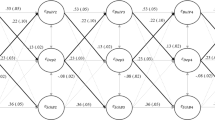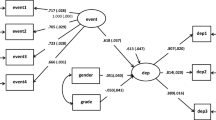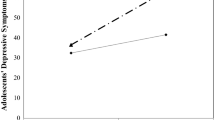Abstract
The majority of research on the outcome of school violence has been conducted in Western countries. Empirical studies on how school violence impacts student psychological well-being in a Chinese cultural context are relatively limited. The aim of this study was to address this gap by exploring how student maltreatment by teachers, student perpetration against students, and student victimization by other students affected the self-esteem and depression of 1,376 junior high school students in Taiwan. The current study also explored how gender, family socioeconomic status (SES), student–teacher relationships and peer support moderate the impact of school violence. Structural equation analyses showed that student victimization by students and student perpetration of violence against students successfully predicted depression, but not self-esteem. Student maltreatment by teachers was associated with neither depression nor self-esteem. Multigroup analyses showed that relationships among the variables were similar across gender, family socioeconomic status, or student–teacher relationships. However, the impact of student victimization on depression was stronger for subgroups with a low level of peer support than for those with a high level of peer support. The overall findings suggest that depression is the major consequence of school violence in Taiwan and that the impact of student victimization by fellow students on depression is buffered by positive peer support. Implications for theory, intervention and recommendations for future research are discussed.






Similar content being viewed by others
References
Alhija, F. N., & Wisenbaker, J. (2006). A monte carlo study investigating the impact of item parceling strategies on parameter estimates and their standard errors in CFA. Structural Equation Modeling: A Multidisciplinary Journal, 13(2), 204–228.
Astor, R. A., Benbenishty, R., Pitner, R., & Zeira, A. (2004). Bullying and peer victimization in schools. In P. A. Meares & M. W. Fraser (Eds.), Intervention with children and adolescents: An interdisciplinary perspective (pp. 448–471). Boston: Pearson.
Baldry, A. C. (2003). Bullying in schools and exposure to domestic violence. Child Abuse and Neglect, 27(7), 713–732.
Baldry, A. C. (2004). The impact of direct and indirect bullying on the mental and physical health of Italian youngsters. Aggressive Behavior, 30(5), 343–355.
Baumeister, R., Smart, L., & Boden, J. (1996). Relation of threatened egotism to violence and aggression: The dark side of self-esteem. Psychological Review, 103, 5–33.
Benbenishty, R., & Astor, R. A. (2005). School violence in context: Culture, neighborhood, family, school, and gender. New York, US: Oxford University Press.
Benbenishty, R., Zeira, A., & Astor, R. A. (2002a). Children’s reports of emotional, physical and sexual maltreatment by educational staff in Israel. Child Abuse and Neglect, 26, 763–782.
Benbenishty, R., Zeira, A., Astor, R. A., & Khoury-Kassabri, M. (2002b). Maltreatment of primary school students by educational staff in Israel. Child Abuse and Neglect, 26(12), 1291–1309.
Bentler, P. M. (1990). Comparative fit indexes in structural models. Psychological Bulletin, 107, 238–246.
Bentler, P. M. (1992). On the fit of models to covariances and methodology to the Bulletin. Psychological Bulletin, 112, 400–404.
Bentler, P. M., & Bonnett, D. G. (1980). Significance tests and goodness of fit in the analysis of covariance structures. Psychological Bulletin, 88, 588–606.
Bollen, K. A. (1989). A new incremental fit index for general structural models. Sociological Methods & Research, 17, 303–316.
Boucher, H., Peng, K., Shi, J., & Wang, L. (2009). Culture and implicit self-esteem: Chinese are “good” and “bad” at the same time. Journal of Cross-Cultural Psychology, 40, 24–45.
Chen, X. (2000). Growing up in a collectivistic culture: Socialization and socioemotional development in Chinese children. In A. L. Comunian & U. P. Gielen (Eds.), Human development in cross-cultural perspective (pp. 331–353). Lengerich, Germany: Pabst Science.
Cheng, C. (2001). Perceived variability in social relations and psychological distress: Toward a variability approach to subclinical depression. International Journal of Group Tensions, 30(2), 117–133.
Chen, J. K., & Astor, R. A. (2009a). The perpetration of school violence in Taiwan: An analysis of gender, grade level, school type. School Psychology International, 30, 568–584.
Chen, J. K., & Astor, R. A. (2009b). Students’ reports of violence against teachers in Taiwanese schools. Journal of School Violence, 8(1), 2–17.
Chen, J. K., & Astor, R. A. (in press). School violence perpetration in Taiwan: Examining how western risk factors predict school violence in an Asian culture. Journal of Interpersonal Violence.
Cowie, H., & Olafsson, R. (2000). The role of peer support in helping the victims of bullying in a school with high levels of aggression. School Psychology International, 21(1), 79–95.
Davidson, L. M., & Demaray, M. K. (2007). Social support as a moderator between victimization and internalizing-externalizing distress from bullying. School Psychology Review, 36(3), 383–405.
Demaray, M. K., & Malecki, C. K. (2003). Perceptions of the frequency and importance of social support by students classified as victims, bullies, and bully/victims in an urban middle school. School Psychology Review, 32, 471–489.
Flannery, D. J., Singer, M. I., & Wester, K. L. (2004). Impact of exposure to violence in school on child and adolescent mental health and behavior. Journal of Community Psychology, 32(5), 559–573.
Furlong, M. J., Chung, A., Bates, M. P., Whipple, A. D., Jimenez, T. C., & Morrison, R. L. (2005). Development of California school climate and safety survey-short form. Psychology in the Schools, 42(2), 137–149.
Furlong, M. J., Morrison, R., Bates, M., & Chung, A. (1998). School violence victimization among secondary students in California: Grade, gender, and racial-ethnic incidence patterns. The California School Psychologist, 3, 71–87.
Furlong, M., Whipple, A., Jean, G., Simental, J., Soliz, A., & Punthuna, S. (2003). Multiple contexts of school engagement: Moving toward a unifying framework for educational research and practice. California School Psychologist, 8, 99–113.
Gentile, B., Grabe, S., Dolan-Pascoe, B., Twenge, J. M., & Well, B. E. (2009). Gender differences in self-esteem: A meta-analysis. Review of General Psychology, 13(11), 34–45.
Gladstone, G. L., Parker, G. B., & Malhi, G. S. (2006). Do bullied children become anxious and depressed adults?: A cross-sectional investigation of the correlates of bullying and anxious depression. Journal of Nervous and Mental Disease, 194(3), 201–208.
Graham, S., & Bellmore, A. D. (2007). Peer victimization and mental health during early adolescence. Theory into Practice, 46(2), 138–146.
Hahm, H. C., & Guterman, N. B. (2001). The emerging problem of physical child abuse in South Korea. Child Maltreatment, 6(2), 169–179.
Hu, L. T., & Bentler, P. M. (1999). Cutoff criteria for fit indexes in covariance structure analysis: Conventional criteria versus new alternatives. Structural Equation Modeling: A Multidisciplinary Journal, 6, 1–55.
Juvonen, J., Graham, S., & Schuster, M. (2003). Bullying among young adolescents: The strong, the weak, and the troubled. Pediatrics, 112, 1231–1237.
Kaplan, H. B., & Pokorny, A. D. (1969). Self-derogation and psychosocial adjustment. Journal of Nervous and Mental Disease, 149, 421–434.
Khoury-Kassabri, M. (2006). Student victimization by educational staff in Israel. Child Abuse and Neglect, 30(6), 691–707.
Kim, Y. S., Koh, Y. J., & Leventhal, B. (2005). School bullying and suicidal risk in Korean middle school students. Pediatrics, 115(2), 357–363.
Kim, Y. S., Leventhal, B. L., Koh, Y. J., Hubbard, A., & Boyce, W. T. (2006). School bullying and youth violence—causes or consequences of psychopathologic behavior? Archives of General Psychiatry, 63(9), 1035–1041.
Klomek, A. B., Marrocco, F., Kleinman, M., Schonfeld, I. S., & Gould, M. S. (2008a). Peer victimization, depression, and suicidiality in adolescents. Suicide and Life-Threatening Behavior, 38(2), 166–180.
Klomek, A. B., Sourander, A., Kumpulainen, K., Piha, J., Tamminen, T., Moilanen, I., et al. (2008b). Childhood bullying as a risk for later depression and suicidal ideation among finnish males. Journal of Affective Disorders, 109(1–2), 47–55.
Kochenderfer-Ladd, B., & Skinner, K. (2002). Children’s coping strategies: Moderators of the effects of peer victimization? Developmental Psychology, 38, 267–278.
Lakey, B., & Cohen, S. (2000). Social support theory and selecting measures of social support. In S. Cohen, L. U. Gordon, & B. H. Gottlieb (Eds.), Social support measurement and interventions: A guide for health and social scientists. New York: Oxford.
Lee, Yu-Feng L. (2008). Economic growth and income inequality: The modern Taiwan experience. Journal of Contemporary China, 17(55), 361–374.
Lee, M., Lee, Y., Yen, L., Lin, M., & Lue, B. (1990). Reliability and validity of using a brief psychiatric symptom rating scale in clinical practice. Journal of the Formosan Medical Association, 89, 1081–1087.
Little, T., Lindenberger, U., & Nesselroade, J. R. (1999). On selecting indicators for multivariate measurement and modeling with latent variables. Psychological Methods, 4, 192–211.
Malecki, C. K., & Demaray, M. K. (2002). Measuring perceived social support: Development of the child and adolescent social support scale. Psychology in the Schools, 39, 1–18.
Malecki, C. K., & Elliott, S. N. (1999). Adolescents’ ratings of perceived social support and its importance: Validation of the student social support scale. Psychology in the Schools, 36, 473–483.
Marsh, H. W., Hau, K.-T., Balla, J. R., & Grayson, D. (1998). Is more ever too much? The number of indicators per factor in confirmatory factor analysis. Multivariate Behavioral Research, 33, 181–220.
McFarlane, A. H., Bellissimo, A., & Norman, G. R. (1995). The role of family and peers in social self-efficacy: Links to depression in adolescence. American Journal of Orthopsychiatry, 65(3), 402–410.
Moore, M. O., & Kirkham, C. (2001). Self-esteem and its relationship to bullying behaviour. Aggressive Behavior, 27(4), 269–283.
Mruk, C. J. (2006). Self-esteem research, theory, and practice: Toward a positive psychology of self-esteem. New York: Springer Publishing Company.
Nansel, T. R., Overpeck, M., Pilla, R. S., Ruan, W. J., Simons-Morton, B., & Scheidt, P. (2001). Bullying behaviors among US youth: Prevalence and association with psychosocial adjustment. Journal of the American Medical Association, 285, 2094–2100.
Naylor, P., & Cowie, H. (1999). The effectiveness of peer support systems in challenging school bullying: The perspectives and experiences of teachers and pupils. Journal of Adolescence, 22(4), 467–479.
Ng, J. W. Y., & Tsang, S. K. M. (2008). School bullying and the mental health of junior secondary school students in Hong Kong. Journal of School Violence, 7(2), 3–20.
Nisbett, R. E. (2003). The geography of though: How Asian and Westerners think differently…and why. New York: The Free Press.
Raymore, L. A., & Godbey, G. C. (1994). Self-esteem. Gender, and socioeconomic status: Their relation to perceptions of constraint on. Journal of Leisure Research, 26(2), 99.
Robinson, J. P., Shaver, P. R., & Wrightsman, L. S. (1991). Measures of personality and social psychological attitudes. San Diego: Academic Press.
Rosenberg, M. (1965). Society and the adolescent self-image. Princeton, NJ: University Press.
Rosenberg, M., Schooler, C., Schoenbach, C., & Rosenberg, F. (1995). Global self-esteem and specific self-esteem: different concepts, different outcomes. American Sociological Review, 60(1), 141–156.
Salmivalli, C. (2001). Feeling good about oneself, being bad to others? Remarks on self-esteem, hostility, and aggressive behavior. Aggression and Violent Behavior, 6(4), 375–393.
Seals, D., & Young, J. (2003). Bullying and victimization: Prevalence and relationship to gender, grade level, ethnicity, self-esteem, and depression. Adolescence, 38(152), 735–747.
Shahani, C., Dipboye, R. L., & Phillips, A. P. (1990). Global self-esteem as a correlate of work-related attitudes: A question of dimensionality. Journal of Personality Assessment, 54, 276–288.
Tiwari, A., Wong, M., & Ip, H. (2001). Ren and yuan: A cultural interpretation of Chinese women’s response to battering. Canadian Journal of Nursing Research, 33, 63–79.
Triandis, H. C. (1995). Individualism and collectivism. Boulder, CO: Westview Press.
Tsai, J. L., & Levenson, R. W. (1997). Cultural influences on emotional responding: Chinese American and European American dating couples during interpersonal conflict. Journal of Cross-cultural Psychology, 28(5), 600–625.
Twenge, J. M., & Nolen-Hoeksema, S. (2002). Age, gender, race, socioeconomic status, and birth cohort differences on children’s depression inventory: A meta-analysis. Journal of Abnormal Psychology, 111(4), 578–588.
Wade, T. J., Cairney, J., & Pevalin, D. (2002). The emergence of gender differences in depression among adolescents: National panel results from the USA, Canada, and Great Britain. Journal of the American Academy of Child and Adolescent Psychiatry, 41(2), 190–198.
Wei, H. S., Chang, H. Y., & Chen, J. K. (2006). Taichung City youth life conditions survey. Taichung: Children’s Bureau.
Wei, H. S., & Chen, J. K. (2009). Social withdrawal, peer rejection and victimization: An examination of path models. Journal of School Violence, 8(1), 18–28.
Williams, T., Connolly, J., Pepler, D., & Craig, W. (2005). Peer victimization, social support, and psychosocial adjustment of sexual minority adolescents. Journal of Youth and Adolescence, 34(5), 471–482.
Wu, J., Lee, K. C., Yin, M. J., & Hu, S. Z. (2000). Taiwan Di Qu Qing Shao Nian Xiao Yuan Bao Li Fang Zhi Ji Hua [Prevention and Control of School Violence in Taiwan]. Taipei, Taiwan: National Science Council. (NSC 89–2420-H-006–001-QBS).
Yang, S., Kim, J., Kim, S., Shin, I., & Yoon, J. (2006). Bullying and victimization behaviors in boys and girls at South Korean primary schools. Journal of the American Academy of Child and Adolescent Psychiatry, 45(1), 69–77.
Zeira, A., Astor, R. A., & Benbenishty, R. (2002). Sexual harassment in Jewish and Arab public schools in Israel. Child Abuse and Neglect, 26(2), 149–166.
Author information
Authors and Affiliations
Corresponding author
Rights and permissions
About this article
Cite this article
Chen, JK., Wei, HS. The Impact of School Violence on Self-Esteem and Depression Among Taiwanese Junior High School Students. Soc Indic Res 100, 479–498 (2011). https://doi.org/10.1007/s11205-010-9625-4
Accepted:
Published:
Issue Date:
DOI: https://doi.org/10.1007/s11205-010-9625-4




